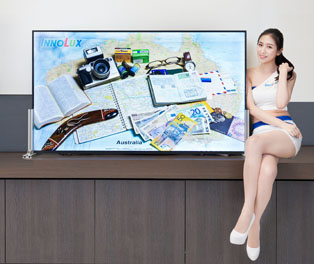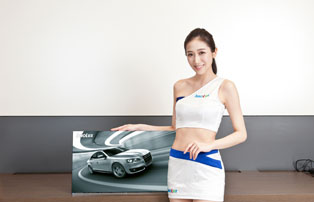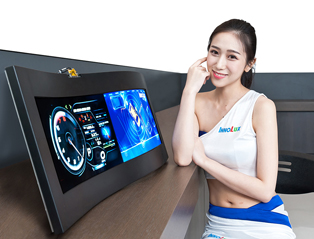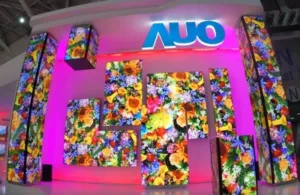Touch Taiwan took place in Taipei and there were, of course a number of news items that came out of it.
AUO was collaborating with IAdea to show synchronised LCD displays as it did at ISE in February. (ISE 2017 Round Up)
A highlight was a range of narrow bezel TV displays in 85″ with 8K resolution and in 65″ and 75″ in UltraHD and exploiting its GOA (gate on array) technology. The 85″ can support 120Hz, which is being regarded as an essential part of the full 8K experience.
Gaming is a hot topic and the company had a 27″ UltraHD HDR monitor that can support refresh up to 144Hz. It has support for 99% of AdobeRGB. A 35″ gaming monitor has 3440 x 1440 resolution with support for up to 200Hz. For grading, there is a new 32″ UltraHD panel that supports HDR10 and also covers 99% of AdobeRGB.
For signage, a key application for AUO going forward, there was an 85″ UltraHD display with 2,500 cd/m² of output as well as 55″ video wall displays with a combined bezel of 1.8mm.
It was also showing notebook panels and emphasised its LTPS capability, as it did at SID. There was a 13.3″ UltraHD LTPS notebook panel with 332 ppi and a border of only 1.5mm. Another 15.6″ panel has 100% Adobe RGB support and bezels of just 2mm. Also in 13.3″, there was an on-cell touch panel, and this technology was also shown in a 6″ FullHD panel which uses an integrated touch and driver chip. The border is just 0.6mm borders on all sides and the panel is available in 18:9 (2160 x 1080).
In automotive, the company had a 12.3″ FullHD LTPS display with 1.5mm borders. A specialised 4.5″ transflective display is aimed at motorcycle riders that need good performance in high brightness. Wearable display included the 1.2″ and 1.4″ circular AMOLEDs were shown alongside the 1.3″ touch-enabled panel. Finally, the company had folding and flexible displays with a 5″ rollable OLED that is just 0.1mm thick and 5g in weight and foldable to a 4mm rolling radius.

CPT was talking about a development to produce new LEDs using Quantum Dots to produce large pixel displays with a 2mm x 2mm area. The LEDs are created using a printing method to deposit the QD materials. The company also showed, with Imec, a high resolution display that we have reported on separately. (IMEC and CPT Show Patterned OLEDs)

E Ink had a booth at the show and was showing a wide range of differently-sized displays including an 84″ tiled digital signage display.
 E Ink showed this 84″ display at Touch Taiwan
E Ink showed this 84″ display at Touch Taiwan
E Ink also showed the latest iteration of its advanced colour ePaper (ACeP) and foldable ePaper. The company also had the Quilla interactive displays that we have reported on since we first saw them at Infocomm last year. There have been developments in pen-based touch for notebooks and, of course, a range of eBooks. ESLs and electronic bag tags were included in the demos as well as a number of shipping wearable products. There’s a video online.
 Innolux showed a 100″ UltrHD TV panel that has 1,200 cd/m² of brightness making it suitable for high end sets. The panel uses quantum dots for wide colour gamut and the panel won an award as an Outstanding Product at the event. It uses new high-speed driver chips.
Innolux showed a 100″ UltrHD TV panel that has 1,200 cd/m² of brightness making it suitable for high end sets. The panel uses quantum dots for wide colour gamut and the panel won an award as an Outstanding Product at the event. It uses new high-speed driver chips.
A second TV panel with quantum dots has a 65″ diagonal and divides the display into more than 1,000 zones for high dynamic contrast. A colour gamut of more than 90% of BT 2020 combined with brightness of more than 1,000 cd/m² is said to make the panel competitive in quality with an OLED panel. The panel has a new backlight structure that Innolux claims that allows a directly-lit panel to be as thin as an edge-lit panel.
Another 65″ panel supports 8K resolution and the same level of brightness and is claimed to reduce colour cast prolems that can often be seen in wide-angle displays and the company claims that it has the best viewing angle in the market.
We reported on the double layer panel made by Panasonic and used for monitors that support HDR and Innolux showed a 50″ panel at Touch Taiwan that uses the same technology to achieve 1,000,000:1 contrast and is claimed to overcome bottlenecks in production. The firm said that the panel is as good as an OLED in achieving night scene without halos.
A 50″ monitor has been developed that is made using one-stop production at the same facility, from open cell to finished product testing. A 55″ video wall panel uses symetrical bezels with a combined width of 1.8mm.
I nnolux was keen to show that it could compete with OLEDs for smartphones and it had a 5.99″ “bezel-less” smartphone display with 18:9 aspect ratio and supporting the DCI P3 colour gamut. There was also a 5.5″ panel with 2560 x 1440 resolution and what is claimed to be the narrowest bezel available at 0.45mm. It also has a wide colour gamut. Another 5.5″ panel is optimised for colour and has 96% of NTSC and 35% more gamut than sRGB . Pushing colour even further, the firm was showing another 5.5″ QuadHD panel that covers DCI-P3 and 115.8% of NTSC and 85% of Rec. 2020.
nnolux was keen to show that it could compete with OLEDs for smartphones and it had a 5.99″ “bezel-less” smartphone display with 18:9 aspect ratio and supporting the DCI P3 colour gamut. There was also a 5.5″ panel with 2560 x 1440 resolution and what is claimed to be the narrowest bezel available at 0.45mm. It also has a wide colour gamut. Another 5.5″ panel is optimised for colour and has 96% of NTSC and 35% more gamut than sRGB . Pushing colour even further, the firm was showing another 5.5″ QuadHD panel that covers DCI-P3 and 115.8% of NTSC and 85% of Rec. 2020.
There was a 6.8″ that uses a piezo controller to vibrate the display to eliminate the need for a speaker (although, bizarrely, Innolux said that it means that the audio jack is not needed!).
In the tablet area, an 8″ tablet panel includes touch with pressure tracking along with 10 finger touch, while a 10.1″ touch panel supports the use of a 2mm touch pen.
Innolux is strong in automotive and a featured display was a 29″ “S”-shaped panel for integrating the dashboard and CID panel into a single unit (see picture). A 10.1″ S-shaped display can be curved to a 170mm radius. A second 10.1″ display has 3K x 1K resolution at 312ppi.
For high end automotive applications, the company had an 8:3 aspect ratio 12.3″ panel with 1,000 cd/m² of brightness and 1,000:1 contrast. The panel supports local dimming to give a high level of dynamic contrast.

Turning to IT and industrial products, Innolux was showing new monitor and notebook panels for gamers that are claimed to reduce blue light by 70% without having a yellow colour cast, which some solutions have. The firm said that the panels have passed the TÜV Rheinland Low Blue Light Testing Standard*. There was a 15.6″ unit and a 17.3″ notebook panel that supports 144Hz operation and has a reduced response time to 5ms on its IPS panel. There is also a 27″ monitor panel with 2560 x 1440 resolution that can go up to 144Hz.
Also in the IT area, Innolux had 14″ and 23.8″ panels which have a switchable privacy mode. A 13.3″ FullHD notebook panel can use as little as 1W in the 150 cd/m² brightness mode, which should make it attractive in notebooks for road warriors.
Like AUO, Innolux had a 31.5″ 4K panel that supports HDR for monitor use.
Industrial displays also saw some innovation and a new 12.1″ XGA panel uses AAS technology for wide viewing, making the panel much more useful in portrait configurations than TN panels. It can support a temperature range of -30~85℃ and has brightness up to 600 cd/m². Another industrial display is a 15.6″ FullHD unit that has a slightly lower temperature range (-30~80℃) and the firm showed a 17″ with 1280 x 1024 resolution and a wide gamut (90% of NTSC – whatever that is!). Finally, the company showed a 12″ touch screen that has been developed with a local automotive maker.
ITRI, the research organisation which is backed by the Taiwanese government, showed a new flexible and foldable display that is said to have been tested with up to 200,000 folds and with a tight folding radius of 3mm. The display is also reported to have been rubbed with steel wool at a pressure of 1Kg. The front of the display uses a patented material which maintains light transmission even under this tough testing regime. Details of the material used were not released, although the organisation has confirmed that it is a composite material. CTimes posted a video of the display.

Analyst Comment
* We still haven’t had a response from TÜV to explain this marking although we have been requesting information for more than a year! It’s one thing to do the development and execute tests, but part of the business is marketing the labels as being valuable. TÜV really seems to be very poor at this. (BR)

